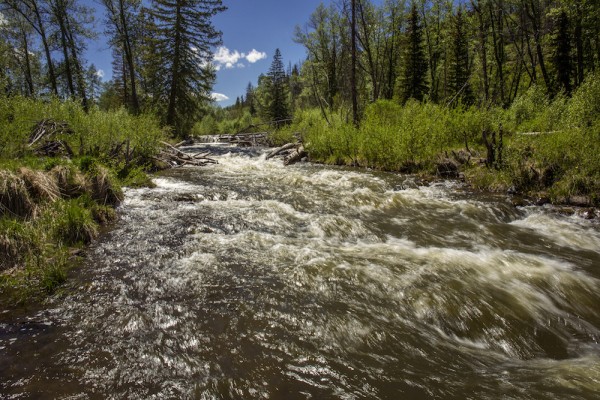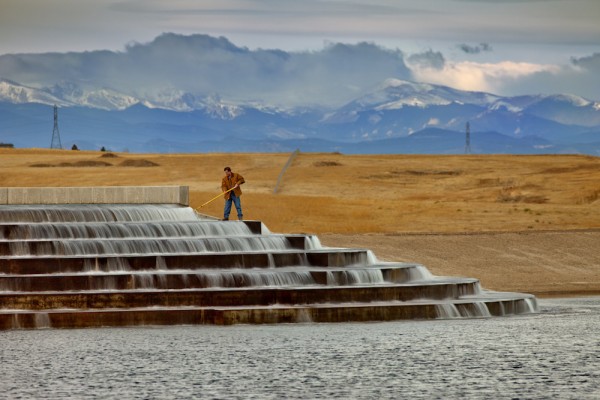Water, when scarce, has split the nation into warring factions. But it has also united fractured regions. Water can both release the demons of war and stir the better angels of our nature.
We hear so much about California and the drought there. But consider the whole West—and the Continental Divide, also known as the Great Divide. This spine of the continent splits North America—and the state of Colorado, where I live—into hydrological halves.
The snowy West Slope of the Great Divide boasts abundant rivers that flow to the Pacific Ocean. The East Slope, which drains to the Atlantic, is decidedly drier but is home to a thirsty agricultural sector and Front Range cities (including Denver and Colorado Springs) that support the vast majority of the state’s population. To address this imbalance, Colorado diverts water from the West Slope of the Great Divide to the East Slope by means of a Rube Goldberg assemblage of dikes, dams, and pipes, including a tunnel that runs beneath the Rocky Mountains the exact length of a half marathon, 13.1 miles. The economic and ecological consequences of this water transfer from one side of the Divide to the other have provoked disputes throughout the state’s history.
Droughts and disconnects between water sources and water needs are by no means exclusive to the western United States. Even in the water-rich Southeast, imbalances between population centers and water supplies have led to conflicts. In the 1980s, severe drought triggered a water dispute between Georgia, Alabama, and Florida when drought-depleted rivers couldn’t satisfy competing needs for agricultural production, municipal use, hydroelectric generation, and environmental health. This tri-state dispute clogged courtrooms and triggered the involvement of the federal government.
Florida also faces water wars within its borders. According to a study by the Natural Resources Defense Council, Florida is one of 14 states at high risk of water shortages by midcentury. The Sunshine State is blessed with an abundance of freshwater in its rural north, but cities desperate for more supply crowd the south. This disparity has exposed chasms between competing economic and environmental interests. Transferring water over long distances in Florida could allow golf courses to remain green in the south while upsetting the balance of ecosystems in the north.
Along with diverting rivers, pumping water from beneath the ground has supported the growth of cities in many parts of the country. It has also revolutionized agriculture, perhaps most notably on the High Plains. This rain-scarce region was transformed into one of the world’s most bountiful breadbaskets by pumping from the Ogallala Aquifer, which stretches from Texas to South Dakota. The Ogallala, which accumulated over millennia as melting Ice Age glaciers soaked into the ground, is now being spent far faster than rain can replenish it. This liquid inheritance is in danger of running dry—and creating skirmishes both within states and across state borders.
Conflict, of course, commands attention. Some of the West’s most iconic stories—from the novel The Virginian to the movie Shane to the Broadway musical Oklahoma!—center on conflicts over scarce water. In my first water book, Dam Nation: How Water Shaped the West and Will Determine Its Future, I spun tense tales of water wars to keep readers, and myself, awake while unpacking complex issues. For instance, one of the West’s most memorable water battles broke out in 1934 when Arizona’s governor, vowing to stop California from completing a dam that was being built to divert water to Los Angeles, dispatched National Guard troops with machine guns to the Colorado River.

Yampa River, Colorado
To say that water is a perennial cause of conflict is to state the obvious, but as I learned while researching The Great Divide, a forthcoming film and book about Colorado’s water issues, that’s not the whole story. What is less apparent, but arguably more significant, is that water scarcity has spurred far-reaching compromises throughout history. When fierce debate over the use of the Colorado River headwaters threatened to fracture the state of Colorado in 1937, a pact was forged to maintain peace across the Great Divide. While negotiating this historic agreement, neither the West Slope nor the East Slope got all the water it wanted. Each side achieved a modest victory, and compromise prevented conflict from escalating into chaos.
Prior to that momentous accord within Colorado, the 1922 Colorado River Compact united seven western states in a far-reaching agreement that negated the need for courtroom brawls. Some argue that the Colorado River Compact should be discarded and replaced with a new interstate agreement that reflects the economic, demographic, and environmental realities of the 21st-century American West. Regardless, over nine decades later, that compact continues to balance water use between states. This is not as exciting a story as the narrative of Chinatown, the film noir classic that shows ruthless power brokers in Los Angeles robbing a river from a rural valley. But as California’s epic drought exposes stark divides between north and south, between cities and agriculture, and between economic development and environmental sustainability, the proven ability of water agreements to bond fractured regions must not be forgotten.
In 2013, after six years of persistent effort to find common ground among competing parties in the state of Colorado, the Colorado River Cooperative Agreement was finalized. This pact created a framework for resolving disputes over the use of West Slope rivers by Denver Water, which supplies 1.3 million people in the city of Denver and its surrounding suburbs. Furthering this cooperative process, Trout Unlimited, a nonprofit conservation organization, and the West Slope’s Grand County joined with Denver Water to craft a plan to heal the ecologically damaged Colorado River headwaters. Former adversaries will work together to improve the health of the watershed while allowing Denver Water to increase the amount of its diversions across the Great Divide during periods of high flow.
Water compromises are not the stuff of scintillating drama. But as we face a future of cities surging with growth in some of the continent’s driest regions, a food supply strained by drought, and ecosystems degraded by depleted aquifers and drained rivers, we must remember that cooperation, not conflict, is the best way to bridge our nation’s many water divides.
Stephen Grace is the author of The Great Divide, a companion book to The Great Divide film by Havey Productions, which will be published in August.
He wrote this for Thinking L.A., a partnership of UCLA and Zócalo Public Square.
*Photos courtesy of Havey Productions.










